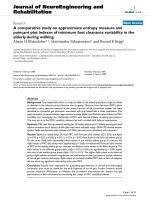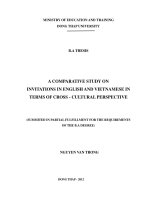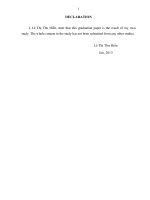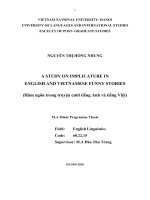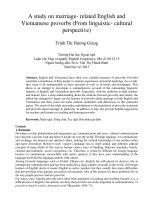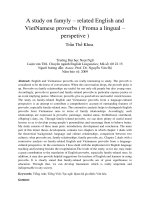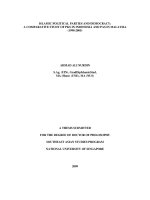A comparative study on complimenting in english and vietnamese conversations
Bạn đang xem bản rút gọn của tài liệu. Xem và tải ngay bản đầy đủ của tài liệu tại đây (930.38 KB, 130 trang )
MINISTRY OF EDUCATION AND TRAINING
QUY NHON UNIVERSITY
NGUYỄN THỊ BÍCH HẬU
A COMPARATIVE STUDY ON COMPLIMENTING IN
ENGLISH AND VIETNAMESE CONVERSATIONS
Field: The English Language
Code: 8 22 02 01
Supervisor: Trương Văn Định, PhD
BỘ GIÁO DỤC VÀ ĐÀO TẠO
TRƯỜNG ĐẠI HỌC QUY NHƠN
NGUYỄN THỊ BÍCH HẬU
NGHIÊN CỨU ĐỐI CHIẾU PHÁT NGƠN KHEN
TRONG HỘI THOẠI ANH VÀ VIỆT
Ngành: Ngôn ngữ Anh
Mã số: 8 22 02 01
Người hướng dẫn: TS. Trương Văn Định
i
STATEMENT OF AUTHORSHIP
I guarantee that the master thesis entitled:
“A comparative study on complimenting in English and Vietnamese
conservations” is the result of my own research. The thesis does not include
any previously published or written documents by others, unless explicitly
referenced within the thesis.
The thesis has not been submitted to any other tertiary institution for a
degree or diploma.
Binh Dinh, October 2023
Author’s signature
Nguyen Thi Bich Hau
ii
ACKNOWLEDGMENTS
This study's completion was made possible via the invaluable support
and dedicated efforts of several individuals who provided assistance, shown
belief in my abilities, and offered encouragement towards the attainment of
the ultimate objective. I would want to express my profound appreciation to
all those involved in this matter.
My wholehearted appreciation goes to my supervisor, Dr. Truong Van
Dinh for his enthusiasm, patience, motivation and friendliness. Throughout
the course of this thesis, the individual in question has provided invaluable
guidance and assistance in shaping the research.
I would like to express my gratitude to the instructors of the English
master's program for imparting significant information, providing insightful
feedback, and sharing valuable resources that greatly facilitated the
completion of my research endeavor. A special mention goes to my best
friends and colleagues whose understanding, sympathy, and support were
invaluable spiritual strength for me during the process of completing this
work.
Last but not least, I owe a great obligation to my parents, who provide
me with advice, unconditional affection, and encouragement to continue my
education and fulfill my dual responsibilities throughout my life.
iii
ABSTRACT
The study aims to investigate the similarities and differences in
complimenting in conversation in English and Vietnamese in terms of
compliment strategies and modality markers displaying politeness. The data
were collected from English and Vietnamese movies as well as English and
Vietnamese publications. This study is carried out on the framework of
Brown and Levinson’s politeness theory (1987). Modality markers and
linguistic forms displaying politeness in complimenting utterances are
presented in the study. The collected data were classified into topics,
compliment strategies and modality markers with a view to pointing out the
English-Vietnamese similarities and differences in offering compliments in
the light of politeness.
As for topics in compliment utterances in English and Vietnamese, the
findings of the study shows that the English and Vietnamese often mention
such topics as physical appearance, capability, character, possessions,
fashion style, manners and social skills. Of these topics, capability is by far
the most mentioned.
As regards strategies employed in compliment utterances in English and
Vietnamese, the findings show the English and Vietnamese use almost the
same number of compliment strategies such as expressing a liking, expressing
admiration, expressing satisfaction and extolling or the combination of some
of these strategies.
In terms of modality markers used in compliment utterances in English
and Vietnamese, the findings show that both the English and Vietnamese use
nearly the same number of MMs in the compliment utterances. However, the
English use more Zero-marker than the Vietnamese while the Vietnamese
favour Intensifier. Moreover, the other MMs are used by the English with a
proportion considerably higher than those by the Vietnamese.
iv
TABLE OF CONTENTS
STATEMENT OF AUTHORSHIP ................................................................... i
ACKNOWLEDGMENTS ................................................................................ ii
ABSTRACT .................................................................................................... iii
TABLE OF CONTENTS ................................................................................ iv
LIST OF ABBREVIATIONS ........................................................................ vii
LIST OF TABLES......................................................................................... viii
LIST OF FIGUIRES........................................................................................ ix
CHAPTER 1. INTRODUCTION.................................................................. 1
1.1. Rationale................................................................................................ 1
1.2. Aim and Objectives ............................................................................... 2
1.2.1. Aim of the study .............................................................................. 2
1.2.2. Objectives of the Study ................................................................... 3
1.3. Research Questions ............................................................................... 3
1.4. Significance of the Study....................................................................... 3
1.5. Scope of the Study................................................................................. 4
1.6. Organization of the Study...................................................................... 5
CHAPTER 2. THEORETICAL BACKGROUND AND LITERATURE
REVIEW.......................................................................................................... 6
2.1. Speech Act Theory ................................................................................ 6
2.1.1. Definition of Speech Act ................................................................. 6
2.1.2. Classification of Speech Acts.......................................................... 7
2.1.3. Speech Act of Complimenting....................................................... 10
2.2. Politeness Theories .............................................................................. 10
2.2.1. Definition of Politeness ................................................................ 10
2.2.2. Rules, principles and theories of politeness ................................. 12
v
2.3. Modality Theories ............................................................................... 17
2.3.1. Definition of Modality .................................................................. 17
2.3.2. Classification of Modality Markers in Conversations.................. 20
2.4. Previous Studies .................................................................................. 20
2.5. Summary.............................................................................................. 25
CHAPTER 3. METHODOLOGY AND PROCEDURES ........................ 26
3.1. Research methods ................................................................................ 26
3.2. Research Procedures............................................................................ 26
3.3. Data Collection.................................................................................... 27
3.4. Data Analysis....................................................................................... 27
3.5. Validity and Reliability ....................................................................... 30
CHAPTER 4. FINDINGS AND DISCUSSION ......................................... 31
4.1. Compliment Topics in English and Vietnamese ................................. 31
4.1.1. Compliment Topics in English...................................................... 31
4.1.2. Compliment Topics in Vietnamese ............................................... 36
4.1.3. Similarities and Differences in Compliment Topics in English and
Vietnamese.............................................................................................. 42
4.2. Compliment Strategies in English and Vietnamese ............................ 43
4.2.1. Compliment Strategies in English ................................................ 43
4.2.2. Compliment Strategies in Vietnamese .......................................... 49
4.2.3. Similarities and Differences of Compliment Strategies in English
and Vietnamese....................................................................................... 54
4.3. Modality Markers in Compliment Utterances in English and
Vietnamese ................................................................................................. 55
4.3.1. Modality Markers in Compliment Utterances in English............. 56
4.3.2. Modality Markers in Compliment Utterances in Vietnamese ...... 65
vi
4.3.3. Similarities and Differences in Use of Modality Markers in
Compliment Utterances in English and Vietnamese .............................. 71
CHAPTER 5. CONCLUSION..................................................................... 74
5.1. Conclusion........................................................................................... 74
5.1.1. Summary of Topics in ompliment Utterances in English and
Vietnamese.............................................................................................. 74
5.1.2. Summary of Strategies Employed in Compliment Utterances in
English and Vietnamese ......................................................................... 75
5.1.3. Summary of Modality Markers Used in Compliment Utterances in
English and Vietnamese ......................................................................... 75
5.2. Implications ......................................................................................... 76
5.3. Limitations of the Study ...................................................................... 77
5.4. Suggestions for Further Research........................................................ 77
REFERENCES ............................................................................................. 78
APPENDICES
vii
LIST OF ABBREVIATIONS
FTA Face-threatening Act
H Hearer
MM Modality marker
MMs Modality markers
S Speaker
viii
LIST OF TABLES
Table 2.1.Functions of speech acts (following Searle 1979) Yule (1996,
p.55) ................................................................................................. 8
Table 2.2.Types of communicative illocutionary acts (Bach & Harnish,
1979, p.41)........................................................................................ 9
Table 4.1.Distribution of Compliment Topics in English .............................. 31
Table 4.2 Distribution of Compliment Topics in Vietnamese........................ 36
Table 4.3 Distribution of Comliment Topics in English and Vietnamese...... 42
Table 4.4.Distribution of Compliment Strategies in English ......................... 44
Table 4.5. Distribution of Compliment Strategies in Vietnamese.................. 49
Table 4.6. Distribution of Compliment Strategies in English and
Vietnamese ..................................................................................... 54
Table 4.7. Distribution of Modality Markers in Compliment Utterances in
English............................................................................................ 57
Table 4.8. Distribution of Modality Markers in Compliment Utterances in
Vietnamese ..................................................................................... 65
Table 4.9. Distribution of Modality Markers in Compliment Utterances in
English and Vietnamese ................................................................. 72
ix
LIST OF FIGUIRES
Figure 1. Possible strategies for doing FTAs ................................................. 15
1
CHAPTER 1. INTRODUCTION
1.1. Rationale
Communication is a basic need of every person from birth to death that
happens every day, anytime, anywhere, in any field. People with good
communication skills will have wide relationships, easy promotion.
Especially in the 21st century, communication skills are even more necessary.
Even if you are a good teacher, if you do not know how to communicate and
convey ideas to students, you will not be appreciated. As a manager, if you do
not know how to express yourself to your superiors and connect with your
subordinates, you cannot succeed. As a business person, if you do not know
how to communicate, you will not be able to sell many goods. Good
communication skill is a prerequisite for establishing a standard in the culture
of daily life and communication. Whether in Western countries or in Vietnam,
the art of communication is always a decisive factor for success or failure in
all relationships.
“Compliment” is a behaviour that exists in all cultures and at all times.
It is also a speech act performed in every language. In our society,
compliments are one of the most extraordinary components of social life. If
given right they create so much positive energy that they make things happen
almost as if by magic. When you compliment someone, you not only make
that person feel great, you also make them want to experience it again. Giving
praise is a good habit and behavior, both chemically and intellectually.
Everyone wants to be praised and appreciated, so it is really necessary for
every person. In every case, compliments are little gifts of love. Although
they are not asked for or demanded, they tell a person they are worthy of
notice. Therefore, the art of the compliment is not only a powerful social skill
but also requires wisdom and tact.
2
Many people who communicate cross-cultural boundaries have
experienced communication breakdowns with people from different first
language backgrounds. At present, cultural activities between Vietnamese and
foreign partners, with English as a communication tool, are taking place very
actively. It is certain that these activities cannot avoid what linguists call
"culture shock", "cultural conflict" and "communication breakdown" because
of differences in language and culture. Therefore, there is really neccesary for
the study of the similarities and differences of the speech acts in the aspect of
linguistic politeness in English and Vietnamese conversations.
In Vietnamese culture, a culture of distinctive community
characteristic, caring for others is very normal. The first and most generous
reason to compliment someone is that you appreciate their existence. We all
love to be recognized and feel good about ourselves. It is considered rude
when we ignore someone's achievement and don't acknowledge them.
In American English, we use compliments for a variety of reasons.
Expressing admiration or approbation of someone's work/ appearance/ taste is
the first and most charitable reason to compliment someone (Manes, 1983;
Herbert, 1990).
It is because of clear differences in Vietnamese and English cultures
regarding the interest in private matters in communication that a study of “A
comparative study on complimenting in English and Vietnamese
conservations” will contribute significantly to the success of Vietnamese-
English cultural communication and in teaching English in the direction of
communicative approach.
1.2. Aim and Objectives
1.2.1. Aim of the study
The purpose of this research is to examine the similarities and
differences in complimenting in conversations in English and Vietnamese in
3
terms of topics of compliment, compliment strategies and modality markers
displaying politeness.
1.2.2. Objectives of the Study
To accomplish the research's purpose, the researcher directs their
attention towards the following aims:
- To investigate the topics mentioned in compliment utterances in
English and Vietmamese.
- To examine the similarities and differences in compliment strategies in
English and Vietnamese compliment utterances.
- To explore the similarities and differences in the use of modality
markers displaying politeness in English and Vietnamese compliment
utterances.
1.3. Research Questions
In order to achieve the aim and objectives of the study, the following
research inquiries will be examined:
1. What topics are mentioned in compliment utterances in English and
Vietnamese?
2. What compliment strategies are used in English and Vietnamese
compliment utterances?
3. What modality markers are used in English and Vietnamese
compliment utterances?
1.4. Significance of the Study
Theoretically, first, the present study highlights the role of culture in
verbal behaviors and contributes to the study of a speech act in the light of
pragmatics and linguistic politeness. Furthermore, the use of language
theories' advancements, both domestically and internationally, to investigate
complimenting and politeness strategies used in compliment utterances would
aid in safeguarding the integrity of the Vietnamese language.
4
Practically, the findings of the study demonstrate a number of notable
similarities and differences between English and Vietnamese compliments.
Therefore, the current research will be very beneficial for those engaged in
English language acquisition and those involved in professional
collaborations with international counterparts. It aims to provide them with a
comprehensive understanding of the art of expressing compliments, hence
enhancing communication efficacy and mitigating potential cultural
misunderstandings in cross-cultural interactions.
1.5. Scope of the Study
The focus of this research is to the act of complimenting in English and
Vietnamese conversations. Specifically, it centers only on the analysis of
complement utterances in both languages. It is important to note that this
study does not address or explore any related elements.
Initially, it is noteworthy that the research does not include an analysis
of paralinguistic and extralinguistic variables in communication. This
omission might be attributed to the lack of consensus among linguists about
these aspects.
Furthermore, the language used in this research encompasses both
British English and American English, thereby negating the need to
differentiate between the two variations.
Thirdly, as a result of limitations in terms of available resources and
time, the research primarily concentrates on the analysis of complementing
statements in authentic conversational settings, rather than focusing on
responses to such utterances.
Finally, the study acknowledges the significance of several elements,
including age, gender, social standing, and interlocutor connections, since
they greatly impact the politeness methods used by speakers. Due to several
factors, such as time constraints and limitations in research ability, these
particular features fall beyond the purview of the present study.
5
1.6. Organization of the Study
The study is divided into 5 chapters:
- Chapter 1, Introduction, presents the rationale, aim, objectives, scope
of the study, significance, research questions, methods and organization of the
study.
- Chapter 2, Theoretical background and literature review, presents
theory of speech acts, politeness and modality.
- Chapter 3, Methods and procedures, presents the research methods of
the study, data collection and data analysis.
- Chapter 4, Findings and discussion, presents the results gained in the
processing of the data and discusses the results of the data analysis.
- Chapter 5, Conclusion, summarizes the findings recorded during
making this study, presents the limitations of the study, provides some
suggestions for further study and gives implications on teaching.
6
CHAPTER 2. THEORETICAL BACKGROUND AND
LITERATURE REVIEW
2.1. Speech Act Theory
2.1.1. Definition of Speech Act
In communication, interlocutors perform many different actions via
language. Although these actions are expressed in various forms, they are
generally referred to as speech acts. Speech act was first introduced by Austin
(1962) in "How to do things with words", and was later developed by many
other scholars like Searle (1969), Yule (1996), Back (2003), Bach and
Harnish (1979). Austin discovers that when a person says something, he
simultaneously does something. Austin identifies three distinct levels of
action beyond the act of utterance. He distinguishes the act of saying
something, what a person does in saying it, and what this person does by
saying it, and Austin calls these acts the locutionary, the illocutionary, and the
perlocutionary act, respectively. Yule (1996) explains these 3 acts as follows:
Locutionary act: It is the basic act of producing a meaningful linguistic
expression.
Illocutionary act: It is performed via the communicative force of an
utterance.
Perlocutionary act: It is the effect the speaker intended the utterance to
have on the hearer or listener.
Scholars agree that “speech act is something expressed by an individual
that not only presents information, but performs an action as well”. Basically,
Yule (1996) “in attempting to express themselves, people do not only produce
utterances containing grammatical structures and words, they perform
actions via those utterances” (p.47). Searle (1969) believes that “speech acts
are the basic or minimal unit of linguistic communication” (p.16).
7
Sharing Searle’s view, Richards, et al. (1992) defines, speech act is an
utterance as a functional unit in communication (p.342).
According to Yule (1996), “actions performed via utterances are
generally called speech acts”. Speech acts serve their function once they are
said or communicated and they are commonly referred to acts such as
apologizing, promising, ordering, answering, requesting, complaining,
warning, inviting, refusing, and congratulating.
2.1.2. Classification of Speech Acts
Based on the functions of speech acts, Austin (1962), classified them
into 5 five types of functions, namely: verdictives (e.g., appraising, ...)
exercitives (e.g., appointing, voting, ordering, urging, advising, warning
...), commissives (e.g., promise, propose,...), behabitives (e.g.,
complimenting, apologizing, congratulating, commending, condoling,
cursing and challenging), and expositives (e.g., conceding, assuming,...).
However, Searle (1979, pp.12-17) proposes one of the most influential
and widely used classification of speech acts with a focus on how listeners
respond to utterances, which is on the contrary to Austin (1962), who
focuses his attention on how speakers realize their intentions in speaking
(Wardhaugh, 1986, p.308). Searle’s classification consists of five broad
types, namely:
1. Commissives: committing the speaker to doing something (e.g. a
promise or a threat).
2. Declarations: changing the state of affairs in the world (e.g. a
pronouncement at court).
3. Directives: getting the listener to do something (e.g. a suggestion or a
request).
4. Expressive: expressing feelings and attitudes about something (e.g. an
apology or a complaint).
8
5. Repesentatives: describing states or events in the world (e.g. an
assertion or a report).
Based on Searle’s classification, Yule (1996, p.55) clarifies five
general types of speech acts that in declarations, the speaker (S) causes the
situation (X); in representatives, S believes X; in expressives, S feels X; in
directives, S wants X; and in commissives, S intends X, all of which are
shown in Table 2.1:
Table 2.1.
Functions of speech acts (following Searle 1979) Yule (1996, p.55)
Speech act types Direction of Fit S= speaker
X= situation
Declarations words change the world S causes X
Repesentatives make words fit the world S believes X
Expressives make words fit the world S feels X
Directives make the world fit words S wants X
Commissives make the world fit words S intend X
Bach and Harnish (1979, pp.40-41) divide illocutionary acts into 2
categories: conventional (which consists of effectives and verdictives) and
communicative. Communicative illocutionary acts are constatives,
directives, commissives and acknowledgements. Bach and Harnish’s
classification of communicative illocutionary acts are shown in Table 2.2:
9
Table 2.2.
Types of communicative illocutionary acts (Bach & Harnish, 1979, p.41)
Communicative illocutionary acts
Constatives Directives Commissives Acknowledgements
Assertives Requestives Promises Apologize
Predictives Questions Offers Condole
Retrodictives Requirements Congratulate
Descritives Prohibitives Greet
Ascriptives Permissives Thank
Informatives Adviories Bid
Confirmatives Accept
Concessives Reject
Retractives
Assentives
Dissentives
Responsives
Suggestives
Supportives
According to Bach and Harnish (1979, pp.42-51), constatives express the
belief or desire of the speaker to the hearer, and describes that the Hearer also
believe this; directives show the speaker's attitude towards a future action by
the hearer and express the hope that his/her utterance will be considered as a
reason for the Hearer's actions, commissives show the beliefs and intentions of
the speaker to his/her utterance to force her/him to do something;
acknowledgements express feelings related to the hearer or the speaker's
intent to satisfy a social need to show a certain emotion, especially the belief

